August Data - October Reporting
MICHIGAN UNEMPLOYMENT RATE INCREASES SLIGHTLY IN AUGUST

On a seasonally adjusted basis, Michigan’s unemployment rate edged up by one-tenth of a percentage point to 3.7 percent during August. This marked the first time Michigan’s unemployment rate increased over the month since October 2022.
The U.S. unemployment rate increased between July and August, rising by three-tenths of a percentage point to 3.8 percent. Michigan’s jobless rate was 0.1 percentage points below the U.S. rate. Even though Michigan’s August unemployment rate was lower than the national rate, the state’s jobless rate was still higher than most other states. In August, Michigan’s unemployment rate of 3.7 percent was tied with New Mexico as the 11th highest rate in the nation. Across the country, jobless rates ranged from 1.7 percent in Maryland to 5.4 percent in Nevada.
Over the year, the national unemployment rate edged up by one-tenth of a percentage point, while the statewide unemployment rate was reduced by six-tenths of a percentage point. Michigan’s 0.6 percentage point unemployment rate drop since last year was tied with two other states as the 14th largest decrease.
Over the month, Michigan’s labor force levels rose by 0.5 percent, while the U.S. workforce advanced by 0.4 percent. Statewide employment levels increased by 0.4 percent over the month, while national employment levels were little changed, inching up by only 0.1 percent. Total unemployment in Michigan moved up by 3.4 percent in August, while total unemployment in the U.S. jumped by 8.8 percent.

Source: Local Area Unemployment Statistics, Michigan Center for Data and Analytics, Michigan Department of Technology, Management & Budget
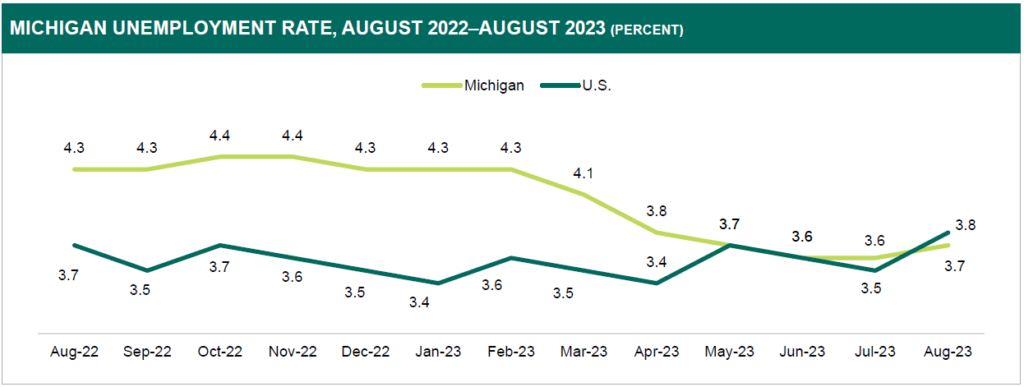
Source: Local Area Unemployment Statistics, Michigan Center for Data and Analytics, Michigan Department of Technology, Management & Budget
Since August 2022, Michigan’s labor force increased by 2.6 percent, seven-tenths of a percentage point above the workforce gain observed nationally. Statewide employment levels rose by 3.2 percent over the year, while nationwide employment levels advanced by 1.8
percent. Over the year, total unemployment in Michigan receded by 11.2 percent, contrary to the
increase of 5.5 percent seen nationally.
REIMA NASSER
Economic Analyst
MICHIGAN NONFARM PAYROLL JOBS FLAT SINCE JUNE
On a seasonally adjusted basis, Michigan nonfarm payroll jobs rose by 4,900 during August to 4,438,900. This month’s employment gain offset last month’s employment drop of 5,100, resulting in jobs remaining essentially flat since June 2023. As of August 2023,
statewide employment was 0.2 percent, or 10,600, below its February 2020 pre-pandemic job level.
Total nonfarm payroll jobs in the U.S. also rose minimally over the month, edging up by 0.1 percent (+187,000) during August. On the national level, seasonally adjusted jobs have been rising since December 2020 and continue to surpass pre-pandemic job levels.
Seasonally adjusted job growth occurred within six of 11 statewide supersector industries this month. On a numeric basis, the largest over-the-month employment gain occurred within Government (+3,300), Leisure and hospitality (+2,700), and Other services (+1,800). In August, several statewide industries recorded job declines too. Notable cuts were recorded within the Professional and business services (-1,800); Trade, transportation, and utilities (-1,200); and Financial activities (-1,000) sectors.
On the nationwide level, several industries including Private education and health services, Leisure and hospitality, and Construction recorded job additions during the month.
Yearly Employment Growth Observed in Majority of Industry Sectors
Over the year, total payroll jobs advanced by +54,400, or 1.2 percent. Since August 2022, eight of Michigan’s 11 super sectors exhibited job growth, with the strongest employment gains led by Government (+19,000), Private education and health services (+17,700), and Leisure and hospitality (+12,700). On a percentage basis, notable job growth was seen within the Construction (+4.4 percent) industry sector.
Since August 2022, seasonally adjusted jobs in the U.S. advanced by 2.0 percent. Over the year, every major industry sector, except for the Information (-1.9 percent) sector, recorded job gains. On a percentage basis, noteworthy job additions were recorded in Mining and logging (+5.1 percent), Leisure and hospitality (+4.5 percent), and Private education and health services (+4.2 percent).
Job Rates Increase in Most Metro Areas During August
On a not seasonally adjusted basis, eight of Michigan’s 14 Metropolitan Statistical Areas (MSAs) recorded job growth, three regions observed job declines, and three regions recorded no job growth since July 2023. All eight of those metro areas recorded employment gains greater than or equal to the national average (+0.2 percent) and six of those metro areas recorded job additions greater than or equal to the statewide average (+0.3 percent).
Total employment within the Manufacturing and Other services industry sectors remained either unchanged or increased in all Michigan metro areas over the month.
Over the year, total payroll jobs remained either unchanged or increased in every Michigan metro area besides the Muskegon MSA (-1.2 percent).
REIMA NASSER
Economic Analyst
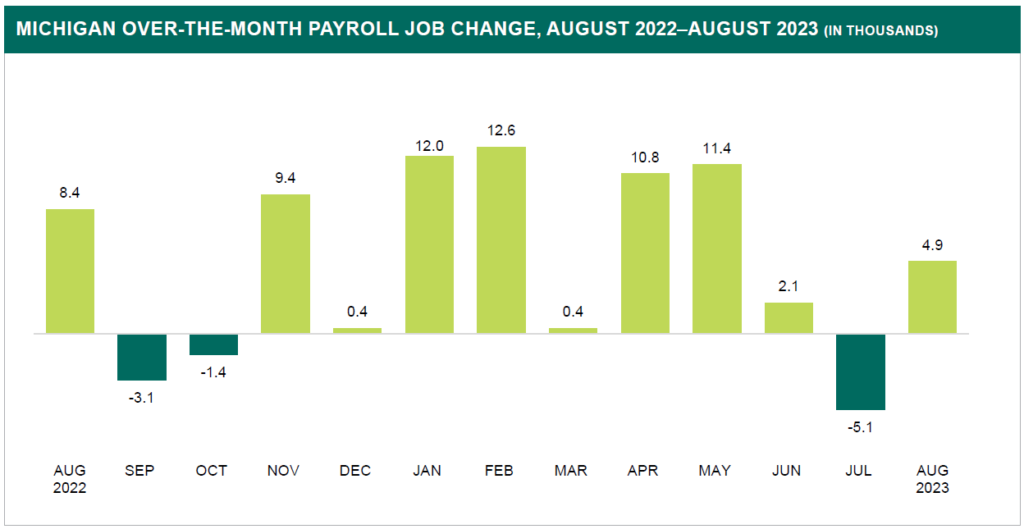

Source: Current Employment Statistics, Michigan Center for Data and Analytics, Michigan Department of Technology, Management & Budget
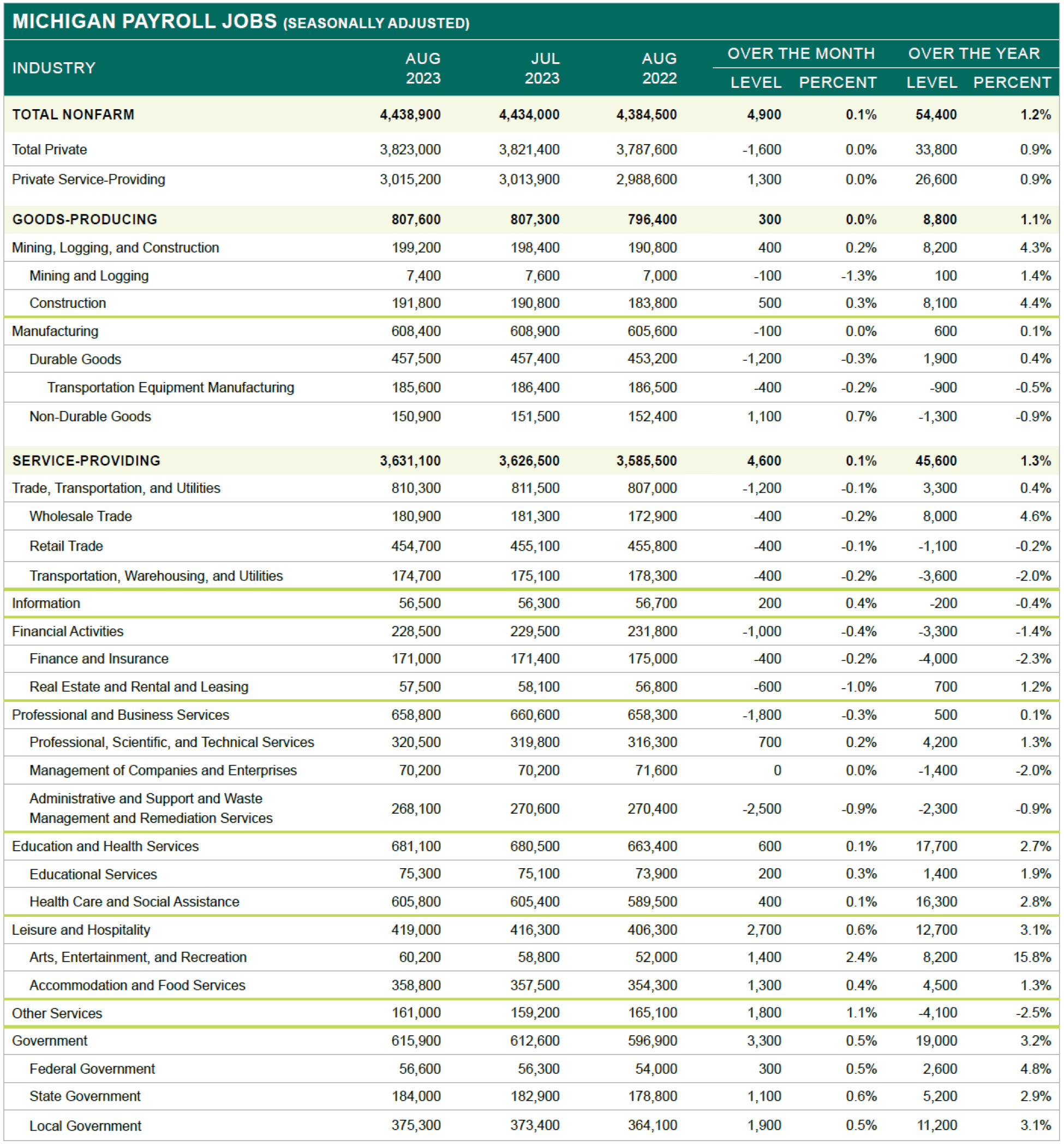
Source: Current Employment Statistics, Michigan Center for Data and Analytics, Michigan Department of Technology, Management & Budget
JOB OPENINGS HIT NEAR THREE-YEAR LOW
Michigan’s job openings rate (4.7 percent) declined in the July release of Job Openings and Labor Turnover Survey (JOLTS) data. The separations rate (3.4 percent) and quits rate (2.1 percent) also declined in the latest data release. Both the layoffs and discharges rate (1.0 percent) and the labor turnover rate (7.1 percent) increased marginally, while hires saw slightly more notable growth (3.5 percent) in July.
Job Openings Fell
Job Job openings in Michigan declined by approximately 19,000 from June (237,000) to July (218,000). This was reflected in a 0.4 percentage point drop in the openings rate, falling from 5.1 percent to 4.7 percent. Michigan had the 3rd lowest job openings rate among states and was 0.6 percentage points below the national average of 5.3 percent.
The unemployed persons to job openings ratio increased in July to 0.81 from 0.74 in the previous month. This meant that for every 10 job openings, there were approximately eight unemployed workers. Michigan had the 6th highest ratio of unemployed persons to job openings in July and was above the national ratio over the same period (0.66). This was the highest ratio Michigan has registered since April 2021 (0.90).
Hires Saw Minor Growth over the Month
The hires rate increased by 0.3 percentage points from 3.5 percent in June to 3.8 percent in July. Numerically, Michigan employers hired approximately 13,000 more individuals in July (166,000) than in June (153,000). Due to this increase in hires, Michigan moved from being one of the states with the lowest rate of hires in the prior month to the middle of the pack as the 27th highest in the latest release.
Separations Inch Downward
Michigan’s separations declined marginally, dropping 0.1 percentage point from 3.5 percent in June to 3.4 percent in July.
The two driving forces of separations—quits and layoffs/discharges—moved in opposite directions. The quits rate dropped to 2.1 percent, a 0.3 percentage point decline from the month prior. Layoffs and discharges however, saw a minor rise, increasing by 0.1 percentage points to 1.0 percent. The greater magnitude of the decline in quits ultimately drove the separations rate down for the month.
Michigan Job Openings Rate Nears Three-Year Low
As previously mentioned, there was a moderate fall in Michigan’s job openings rate from June (5.1 percent) to July (4.7 percent). This gave Michigan the 3rd lowest openings rate behind only New York (4.5 percent) and Hawaii (4.6 percent). Notably, this was the lowest the
openings rate has been since October 2020, where it fell to 4.6 percent. The job openings rate has been trending downward since its peak in June 2021 at 9.4 percent. July marked the first time since November 2020 that there was an openings rate below 5.0 percent. The current July openings rate of 4.7 percent is more in line with the job openings rates from 2017 and 2019 which varied primarily between 4.0 and 5.0 percent.
CANAAN VANMALDEGHEM
Economic Analyst
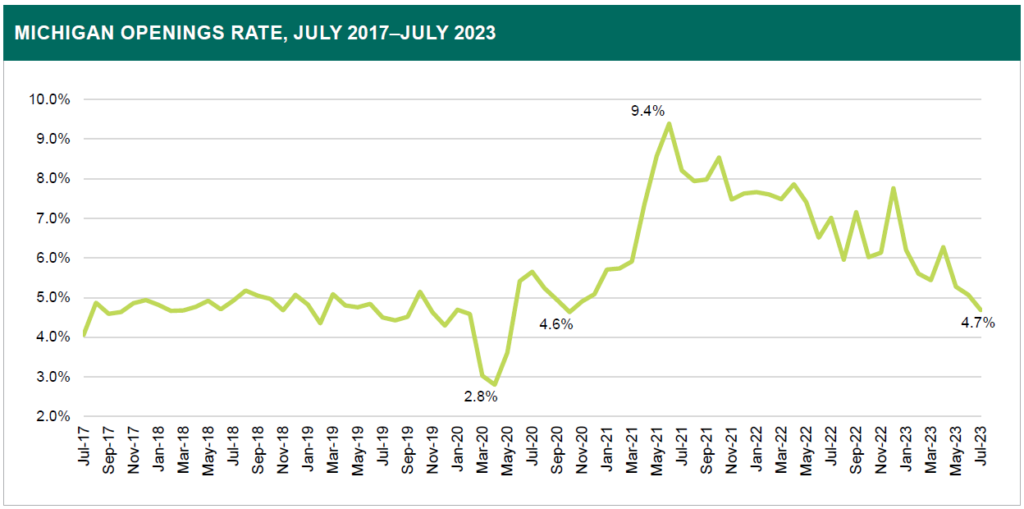
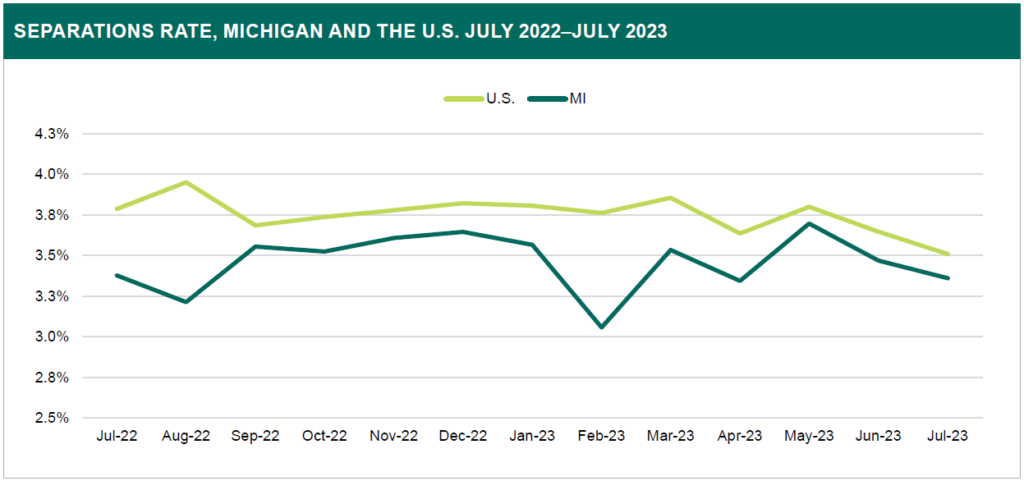
Source: Job Openings and Labor Turnover Survey, U.S. Bureau of Labor Statistics
Disclaimer
The Above Information was created and disseminated by the Department of Technology, Management, and Budget and the Bureau of Labor Market Information and Strategic Initiatives from the State of Michigan. Specialized Staffing does not hold any rights or ownership to this content. For more information, please contact your Michigan Bureau of Labor Representative.
